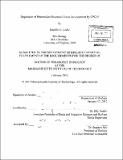Regulation of mammalian neuronal circuit development by CPG 15
Author(s)
Leslie, Jennifer H
DownloadFull printable version (9.418Mb)
Other Contributors
Massachusetts Institute of Technology. Dept. of Biology.
Advisor
Elly Nedivi.
Terms of use
Metadata
Show full item recordAbstract
The orderly assembly of neuronal circuits is specified by developmental programs of gene expression, however, the final stage in circuit development, maturation and refinement of specific synaptic connections, is strongly influenced by neuronal activity. It is thus not surprising that the products of many activity-regulated genes have been implicated in synapse development and plasticity. The extracellular signaling protein CPG15 is one such activity-regulated gene product that promotes the maturation and growth of synapses, dendrites, and axonal arbors during development. Expression of cpg15 mRNA is spatiotemporally correlated with periods of synapse maturation and refinement, posing it to play a central role in the wiring of developing brain circuits. Here we utilize a mouse mutant, which is null for the cpg15 gene (cpg15 KO), to elucidate the mechanism of CPG15 function in the developing brain. Analysis of the cpg15 KO mouse suggests that CPG15 signaling leads to the selection and stabilization of synapses in the developing brain, as well as in the adult. Loss of CPG 15 results in reduced synapse numbers and synapse maturation with a corresponding reduction in the complexity and growth of neuronal arbors. This is most pronounced during early periods of promiscuous synapse formation and arbor growth that provide a physical substrate upon which subsequent experience-dependent processes act to sculpt mature patterns of neuronal connectivity. Consequently, cpg]5 KO mice do not appear to undergo the same extensive refinement as their wild type (WT) counterparts. cpg15 KO mice are also slow learners, requiring repeated training in learning tasks to perform at WT levels. These results led us to propose that the selection and stabilization of synapses by CPG15 mediates optimal wiring of developing neuronal circuits important for brain function throughout life. To test this possibility we investigated the function of CPG15 in the developing thalamocortical circuit in the visual system. The thalamus is the major hub for sensory information flow (minus olfaction) en route from the periphery to the cortex. As CPG15 is expressed in both input and target structures in this circuit we compared cortical synapse development in the global cpg15 KO mouse which lacks CPG15 expression in both the cortex and thalamus to a cortex-specific cpg15 KO mouse which retains thalamic expression of CPG15. Previous work has shown the importance of cortically-derived signaling factors in the maturation of thalamocortical circuits, however, we were surprised to find that CPG15 signaling by the thalamus has a stronger contribution to cortical synapse development than cortical CPG 15. This work reveals a novel function for thalamic signaling in the maturation of cortical circuits.
Description
Thesis (Ph. D.)--Massachusetts Institute of Technology, Dept. of Biology, 2012. Cataloged from PDF version of thesis. Includes bibliographical references.
Date issued
2012Department
Massachusetts Institute of Technology. Department of BiologyPublisher
Massachusetts Institute of Technology
Keywords
Biology.